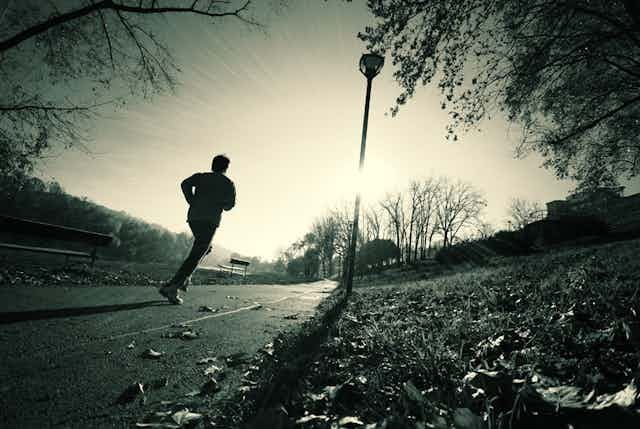Backward running is the latest craze to hit the health and fitness world. After the seven-minute mile was recently cracked, advocates are campaigning for its inclusion in the 2020 Olympic Games. So what are the origins of this crazy sport? What are its benefits? And should you start training for the 2020 Olympics?
The history
Backward running, also known as reverse running or retro running, began as a rehabilitation exercise used by US doctors in the 1970s and 1980s.
But it wasn’t until the start of the new century that it really started hitting its stride in terms of popularity. Now athletes in many sports such as football, tennis, athletics and basketball use backward running as part of their training regime.
There are many backward running races organised throughout the world, and this year sees the fourth world championships being held in Lleida, Spain. The popularity of the sport has even inspired filmmakers, with the soon-to-be released Australian film Reverse Runner telling the story of a teenager who dreams of becoming a backward runner.
The benefits of running backwards
It burns more calories: By using more muscles, backward running burns 20% more calories than forward running. Not only does this make backward running better for weight loss, but the same benefits can be achieved in less time. Similar benefits can be obtained from 100 steps of backward as from 1,000 steps of forward running. This is especially attractive to busy people who want the greatest benefits in the least time.
It improves muscular balance: Forward running mainly uses the hamstrings and knees. Backward running uses the quadriceps, calves and shins. By using opposing muscles to those used in forward running, backward running balances muscular strength.
It reduces the risk of running-related injuries: For most people, forward running is naturally associated with a heel-to-toe strike. This puts a lot of stress on the shins and knees and often causes shin splints, stress fractures and knee problems. Backward running encourages toe-to-heel strike which reduces trauma to the shins and knees.
It improves leg speed and performance during forward running: Backward running shortens the stride and increases leg speed. Participants often report faster forward sprinting speed after backward running. Because backward running uses more muscles and requires more effort than forward running, it is associated with considerable cardiovascular benefit and has been shown to improve endurance performance during forward running.
It rehabilitates knees: Backward running works the muscles around the knee so can be used to strengthen the knee to prevent further injury. Because of its low impact on the knee, backward running can also be used during rehabilitation to maintain cardiovascular fitness while minimising impact.

It improves posture: During backward running, the back is kept straight and the shoulders are held back. Running in this posture works the abdominal muscles more than during forward running and so is better for building abdominal strength.
It improves senses: Because you are blindsided and need to rely on other senses to navigate, participants often report improved hearing and peripheral vision following backward running.
It’s fun: A drawback of running - and especially endurance running - is that is can be tedious. Incorporating backward running into the training session provides variety and the excitement of doing something different.
The negatives
There’s an increased risk of falling: The obvious negative of backward running is the increased risk of falling and possible injury. The risk can be minimised by running on a track or surface that is even and free of obstacles. Some backward runners also wear hats with built-in mirrors.
It doesn’t really train you for forward running: Because backward running uses opposing muscles, and requires different posture and technique, it is non-specific to forward running. For competitive (forward) runners, it should therefore only be used to supplement forward running training and not to replace it.
So, is running backward the new way forward? With so many associated advantages, backward running certainly seems worth trying.
If you’ve ever dreamed of being an Olympian and don’t mind the odd stare, it might be time to don the running shoes and hat with built-in mirror and give backward running a try. If nothing else, it might give you the posture and body fat of a supermodel!

